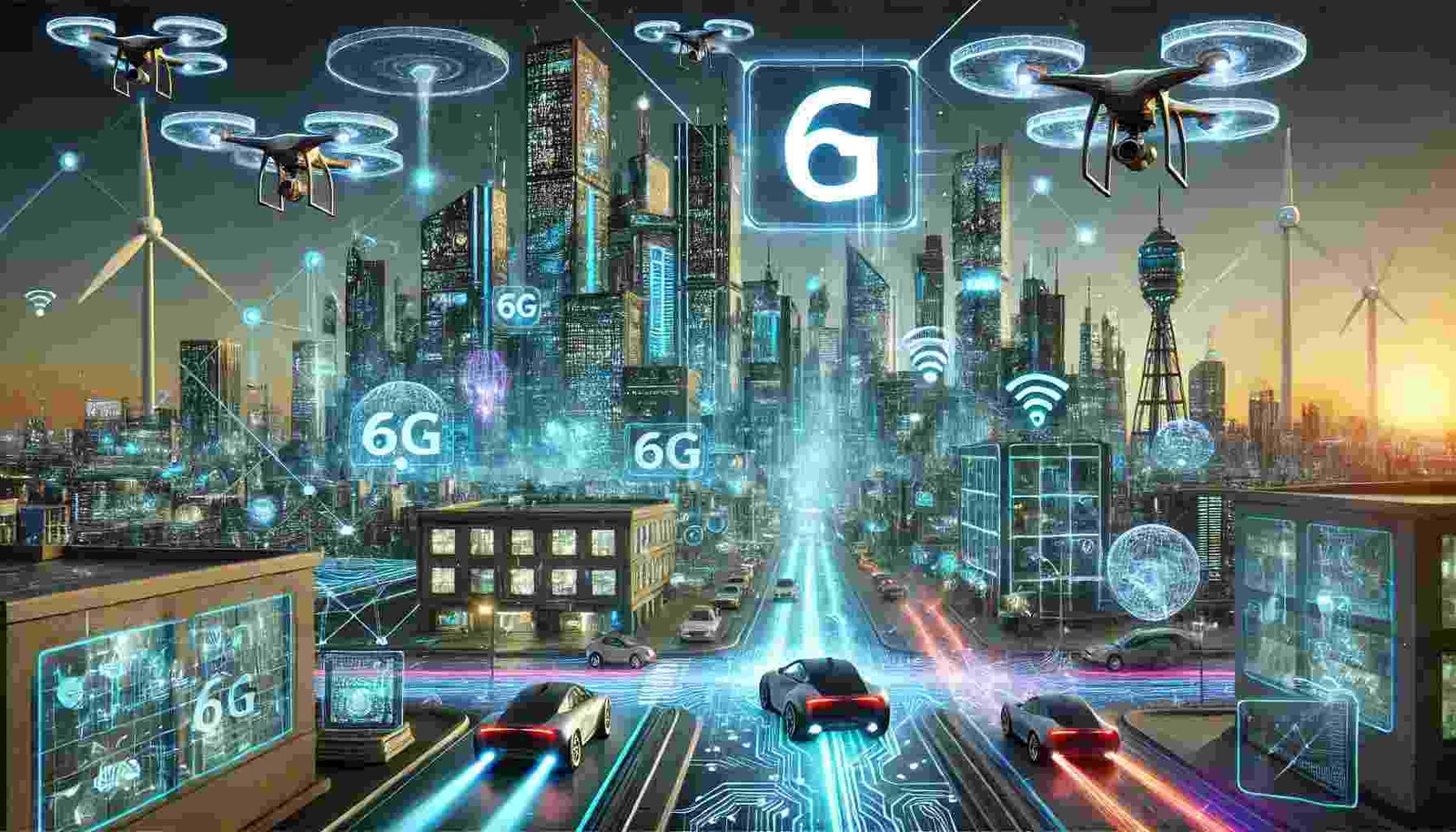As the world becomes increasingly interconnected, the development of wireless technology has been the driving force behind our digital evolution. In the past decade, 5G technology brought a wave of innovation, introducing faster speeds, lower latency, and greater connectivity. However, the world is already looking ahead to the next big leap: 6G Technology Development. With a projected rollout in the early 2030s, the development phase is expected to hit major milestones by 2025, laying the groundwork for a transformative shift in how we interact with technology.
This article will explore how 6G Technology Development in 2025 is poised to revolutionize the digital world, touching on key advancements, expected impacts, and the profound ways it will change industries and daily life.
What is 6G Technology?
6G, the sixth generation of wireless communication technology, is expected to surpass 5G in every metric—speed, bandwidth, latency, and reliability. While 5G boasts impressive speeds of up to 20 Gbps, 6G could increase data transmission rates to 1 terabit per second (Tbps). The leap from 5G to 6G will enable faster-than-ever downloads, hyper-realistic virtual experiences, and advanced connectivity for emerging technologies such as artificial intelligence (AI) and the Internet of Things (IoT).
But 6G is not just about faster speeds. The real game-changer lies in its ability to integrate physical, digital, and biological realms, paving the way for a truly immersive and intelligent future. This means not only enhanced communication but also new capabilities in sensing, edge computing, and automation.
Key Drivers of 6G Technology Development
Several technological advancements will drive the development of 6G in 2025. These include:
1. Spectrum Expansion
One of the biggest changes in 6G technology development will be the use of higher frequency bands, potentially beyond the terahertz spectrum. This will open up enormous bandwidth, allowing for ultra-high-speed data transfer and massive network capacity.
2. AI Integration
6G networks will rely heavily on AI for optimizing network performance. Unlike 5G, which primarily uses AI for basic tasks like signal optimization, 6G networks will be autonomous, able to self-optimize, self-heal, and predict network demands in real time.
3. Edge Computing and Distributed Networks
6G will significantly enhance the role of edge computing, reducing the need to rely solely on central cloud servers for data processing. By processing data closer to the source, 6G will enable faster decision-making for applications such as autonomous vehicles, industrial automation, and real-time medical monitoring.
4. Advanced Sensing Capabilities
6G will integrate sensing technologies into the communication infrastructure. Devices and networks will be capable of sensing their environment, enabling applications like holographic communications, advanced environmental monitoring, and even brain-computer interfaces.
The Expected Impact of 6G Technology Development in 2025
By 2025, 6G technology development will be well underway, setting the stage for transformative impacts across multiple industries. Here’s how 6G is expected to reshape the digital world:
1. Revolutionizing Communication with Hyper-Connectivity
While 5G significantly improved connectivity, 6G will take it to an entirely new level by supporting an unprecedented number of devices per square kilometer. This will enable smart cities, autonomous transportation, and connected ecosystems where everything, from household appliances to streetlights, communicates seamlessly.
With the ability to deliver up to 1 Tbps data speeds and incredibly low latency (as low as 1 millisecond), 6G will enhance the quality of real-time communication and virtual collaboration. Applications like ultra-HD video conferencing, virtual meetings in 3D environments, and holographic telepresence will become mainstream.
2. Enabling the Next Generation of AI and IoT
As AI and IoT technologies advance, 6G will serve as the backbone that enables intelligent, autonomous systems. AI algorithms will be able to process vast amounts of data from connected devices at lightning speed, enabling new levels of automation and decision-making.
For example, in healthcare, 6G will support real-time remote surgeries and monitoring, allowing doctors to diagnose and treat patients from anywhere in the world. In agriculture, IoT-powered smart farms will rely on 6G networks to optimize irrigation, pest control, and crop monitoring, dramatically increasing efficiency and sustainability.
3. Immersive Virtual and Augmented Reality Experiences
One of the most exciting promises of 6G is the potential to make immersive virtual and augmented reality (VR/AR) experiences a daily reality. While 5G supports VR/AR applications, the latency and bandwidth required for fully immersive experiences, such as holographic displays or mixed reality, will be achieved only through 6G.
With ultra-high speeds and lower latency, users will be able to interact with holographic projections in real-time, making virtual meetings, events, and entertainment feel incredibly lifelike. This will transform industries such as entertainment, education, and remote work, enabling entirely new forms of interaction and engagement.
4. Transforming Transportation and Autonomous Systems
6G will play a key role in the development of smart transportation and autonomous systems. By enabling vehicle-to-vehicle (V2V) and vehicle-to-everything (V2X) communication, 6G networks will allow autonomous cars to communicate with each other and with surrounding infrastructure, enhancing safety and efficiency on the roads.
Moreover, drones and autonomous delivery systems will benefit from 6G’s ultra-reliable low-latency communication, making real-time control and navigation more precise. This advancement will revolutionize logistics, emergency services, and urban mobility.
5. Strengthening Data Security and Privacy
With greater connectivity comes the need for enhanced security. 6G technology development is expected to introduce advanced encryption and data protection methods, ensuring that sensitive information is safeguarded in an increasingly connected world.
AI-driven security mechanisms will enable real-time threat detection and prevention, minimizing the risk of cyber-attacks. Additionally, 6G’s ability to distribute data across decentralized networks will reduce single points of failure, enhancing the overall resilience of digital systems.
6. Advancing Sustainable Technologies
As concerns over energy consumption grow, 6G networks will be designed with energy efficiency in mind. By leveraging AI and edge computing, 6G will optimize data processing and reduce the energy footprint of large-scale networks. This will enable smart energy grids, optimized resource distribution, and more sustainable industrial processes.
In environmental monitoring, 6G’s advanced sensing capabilities will enable real-time data collection on climate conditions, pollution levels, and natural resources, supporting efforts to combat climate change and manage ecological systems more effectively.
Challenges in 6G Technology Development
While the potential benefits of 6G are vast, there are also significant challenges to overcome as development progresses in 2025. Key hurdles include:
- Infrastructure Costs: Building the infrastructure needed for 6G networks will require substantial investment. Governments and private companies will need to collaborate to ensure widespread deployment.
- Spectrum Availability: Higher frequency bands will be essential for 6G, but allocating and regulating this spectrum may be complex and contentious, particularly as the demand for wireless communication continues to grow.
- Security Risks: With more connected devices and larger networks, ensuring the security of 6G networks will be a significant challenge. Advanced cybersecurity measures will need to be in place to protect against evolving threats.
Conclusion
As 6G technology development progresses in 2025, it promises to revolutionize the digital world in ways we can only begin to imagine. From hyper-connectivity and immersive virtual experiences to smarter transportation systems and sustainable technologies, 6G will enable groundbreaking innovations across industries. By laying the foundation for faster, more secure, and intelligent networks, 6G will transform how we interact with the digital world and each other, ushering in an era of unprecedented technological advancement.
FAQs:
1. How is 6G different from 5G?
While 5G offers fast speeds and low latency, 6G will significantly enhance these metrics, reaching speeds of 1 Tbps and latency as low as 1 millisecond. Additionally, 6G will focus on AI integration, advanced edge computing, and immersive technologies like virtual and augmented reality, enabling new applications that go beyond what 5G can support.
2. What industries will benefit most from 6G?
Industries such as healthcare, transportation, entertainment, and manufacturing will benefit the most from 6G. For instance, 6G will enable real-time remote surgeries, autonomous transportation, holographic communication, and smart factories with enhanced automation.
3. How will 6G impact daily life?
6G will transform daily life by enabling faster, more immersive communication experiences. Technologies like VR/AR, real-time holographic communication, and seamless connectivity across smart cities will become common, improving how we work, communicate, and interact with the digital world.
4. What role will AI play in 6G networks?
AI will play a crucial role in optimizing 6G networks. 6G will use AI to autonomously manage network performance, predict network demands, and ensure seamless connectivity across millions of devices. AI will also be key in security and data protection by enabling real-time threat detection and mitigation.
5. What challenges are associated with 6G development?
Challenges include the high cost of building 6G infrastructure, allocating higher frequency spectrum, ensuring robust cybersecurity, and developing the necessary regulatory frameworks. Overcoming these challenges will require collaboration between governments, tech companies, and regulatory bodies.
6. When will 6G be available for public use?
6G is currently in the development phase, with major advancements expected by 2025. However, widespread commercial deployment is not expected until the early 2030s, after infrastructure and regulatory frameworks are established.
7. Will 6G be energy efficient?
Yes, energy efficiency is a core focus of 6G development. 6G networks will leverage AI and edge computing to optimize energy consumption, reduce data processing loads, and improve sustainability, making them more energy-efficient than previous generations.
Read Dive is a leading technology blog focusing on different domains like Blockchain, AI, Chatbot, Fintech, Health Tech, Software Development and Testing. For guest blogging, please feel free to contact at readdive@gmail.com.





